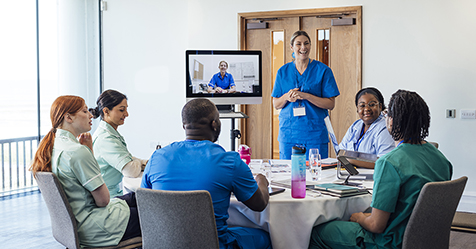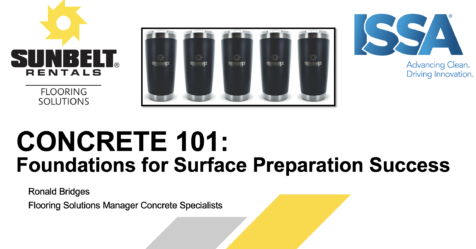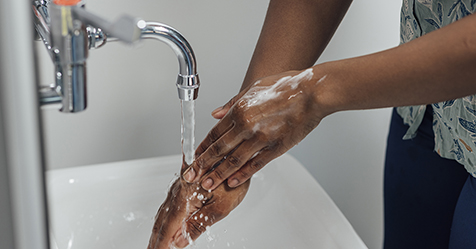Even if a restroom’s toilets, countertops, sinks, and door handles have been disinfected, a building tenant is bound to contaminate the surfaces not too long after the custodian has left. All one has to do is touch the toilet handle, the stall doorknob, and the faucet all before washing his/her hands.
It’s no wonder the restroom is one of the toughest areas to clean—and clean well—in a facility. Here are five questions and answers to help you train your staff so they can tackle this common trouble area.
Q: What cleaning methods and best practices are important for trainees to learn and how should these techniques be carried out?
A: First and foremost, cleaners need to wear personal protective equipment (PPE) including an apron, gloves, and safety glasses. As for cleaning equipment, using microfiber cloths rather than paper towels or terry cloths can help reduce the risk of cross-contamination if used in conjunction with a color-coding system. Standard operating procedure for microfiber use is one per urinal or toilet before retiring them for laundering.
It is important to note that cleaning doesn’t end with the facility. At the end of a shift or location, disinfect spray bottles and the cleaning cart, as it is possible for contaminants that have gotten on protective gloves to transfer to the bottles and cart.
Q: What is the best way to teach trainees best restroom cleaning practices?
A: Instruct using all three adult learning styles: audio, visual, kinesthetic.
- Audio: Speak with trainees and explain why a task is being done. Emphasize the “why.”
- Visual: This is where a color-coded microfiber system can become very helpful. Trainers may even consider coordinating the color of cleaning solutions with the color of microfiber cloths. For many janitorial staff, English may not be their native language. Color coding helps cross this language barrier.
- Kinesthetic: Demonstrate the proper system. Most people learn best with hands-on activity.
Q: Does the size and type of restroom make a difference in training?
A: Yes; size and configuration of the restroom in addition to how facility occupants use the restroom makes a difference. For many restaurants, a predetermined deep cleaning schedule is necessary along with a schedule for other routine cleaning. Executive office settings may require a cleaner who understands how to display supplies on the counter and basin, since presentation may be important to the client. In some cases, there is little or no room for on-site storage of cleaning supplies and equipment, so the cleaner needs to be capable of carrying everything necessary to perform the job.
Q: Can you provide an example of proper protocol for cleaning a toilet/urinal/sink area?
A: First, make sure to take time to do the job right. Dwell time—how long a disinfectant needs to be in contact with a surface to be effective—is important. A dwell time of 10 minutes is required to address bacteria such as E. coli, streptococcus, and methicillin-resistant Staphylococcus aureus (MRSA). When dealing with these types of threats in the restroom, it’s understandable that proper method trumps speed.
However, remember this is a business and the cleaners need to perform in a given amount of time. I recommend the following workflow:
Step 1: Completely wet the surface with disinfectant. Use a 10-minute dwell time.
Step 2: Flush each urinal to provide clean water.
Step 3: Refill all supplies as needed.
Step 4: Begin all dry cleaning.
Step 5: Sweep the floors.
Step 6: Return to each urinal/toilet/sink to complete cleaning with microfiber cloths, using one cloth per fixture.
If the restroom is a multi-stall environment, it’s important to enter each stall, close the door, and latch it shut. When the stall was last occupied, the person had not yet reached a sink to wash their hands. So, whatever was on their hands very likely transferred to the door and latch. If an occupant flushed using his/her feet, then whatever he/she walked through is now on the flush handle.
Q: How do you know if the restroom training is effective?
A: Quality controls must be in place. There are numerous methods to perform quality control assessments. The first is a simple visual inspection. Use a telescopic mirror tool to see the underside of surfaces as well as a blacklight. These tools reveal soils and existing urine, and they are simple to use and inexpensive.
More involved hardware/software inspection tools like adenosine triphosphate (ATP) meters will provide a systematic approach to tracking the activities and results of your cleaning staff. Simply put, if it’s not clean, it’s time to re-train.
The Importance of Training on the Restroom
“Cleaning” sounds easy. But those of us who’ve been in the industry for a decade or more know otherwise. Some companies pay a premium to those cleaning restrooms. How you clean this room, above all others, can make or break your business.



